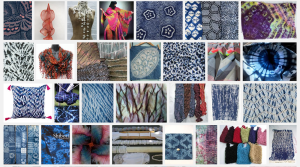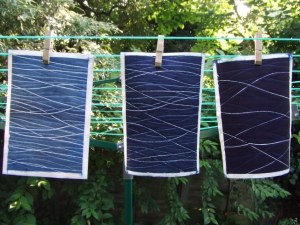Indigo and Shibori by Kim Winter
Today’s post is by Kim Winter of Flextiles. Kim lives in London, UK and has been blogging about her textile experiments since 2011 after taking creative and experimental textiles at Morley College. I follow Kim’s blog and have found it very interesting so I asked her to write an article for us.
Type “tie dye” into Google and a mosaic of fluorescent spirals and sunbursts leaps out of the screen.
But try “shibori”, and the results are more subtle, largely (but not entirely) blue and white.
Yet both are similar techniques – folding, binding, twisting or compressing the cloth so that parts of it are not exposed when it is dyed, resulting in very distinctive patterns.
The Japanese, as with so many craft forms, have developed the techniques even further, wrapping the fabric around poles before binding, using special devices for looping the thread around the cloth, or pulling up rows of stitching very tightly to resist the dye. And the dye often linked with shibori is indigo, which explains the dominance of blue and white designs.
“Like old men’s pee”
I was introduced to shibori and indigo dyeing at my local adult education college in London when I signed up for evening classes in textiles a few years ago. It was a great course, providing an introduction to different techniques over three terms, including wet felting, hand and machine embroidery, and soft basketry.
In the summer term our tutor heaved a large black plastic vat into the room, removed the lid, and I got my first glimpse of an oily, shimmering surface with flecks of froth. It didn’t appeal to everyone – one student described it as “smelling like old men’s pee”. But after a couple of dips, I was hooked.
I’m not going to go into the detailed chemistry here, but a well-maintained indigo vat is not blue – it’s greenish-yellow. Indigo turns blue only when it is exposed to oxygen, so when you remove a piece of fabric from the vat, it changes colour from green to blue before your eyes. It’s quite magical – and very addictive!
It also has the advantage that you don’t need a mordant, so it’s relatively quick compared with some other forms of dyeing. However, to build up colour fastness it’s best to dip several times and leave the fabric to oxidise well between dips.
Shibori obsession
I started off with conventional shibori techniques:
• stitching (nui shibori)
• binding (kumo shibori)
• pole wrapping (arashi shibori)
• clamping with a resist (itajime shibori)
And pretty soon I became obsessed – the experiments in a Kilner jar by the kitchen sink graduated to an increasing number of blue-stained buckets and bowls cluttering up the garden and kitchen, provoking gripes from (otherwise) Ever Supportive Partner!
Then I started experimenting with shibori in other processes.
• Shibori and screenprinting – stitching the fabric before screenprinting over it, then opening the stitching.
• Shibori and felting – binding or wrapping the felt or nuno felt before shrinking in a washing machine or steaming it.
• Shibori on paper – taping the paper to a pipe, wrapping string around the paper, dipping, then adding more string and dipping again.
• Shibori in a heat press – stitching a pattern in synthetic fabric, then putting it with a sheet of disperse dye paper in the heat press.
I also signed up for shibori indigo courses with specialists – an online course with Shibori Girl and a summer school in Norfolk with Jane Callender – where I learnt an incredible amount.
But, as with most textile techniques, there is still so much to learn and experiment with – one day I hope to grow indigo from seed, and produce a naturally fermented indigo vat (not easy in a cold London house). And ultimately I would like to spend some time in Japan, learning more about the whole culture and tradition that surrounds this entrancing dye.
Sustainable scarves
In the meantime, I’ve taken to upcycling scarves from charity shops and vintage sales using shibori and indigo dyeing. This has several advantages:
• It’s more interesting for me, as each scarf is different (colour, size, fabric, pattern) – so I don’t get bored.
• It’s obviously more sustainable – around 500,000 tonnes of clothes get sent to landfill every year in the UK alone, yet many of them are perfectly wearable.
• Because the cost of my raw materials is lower, the price buyers pay is lower too – whether the scarf is made of silk or cashmere. What’s not to like? 🙂
Some of these scarves are available from my Etsy shop; others I sell at various markets around London.
I’ve also started experimenting with natural dyes such as onion skins, coffee and tea.
But I think that indigo will always be my first love. It can be a bit temperamental to work with – the alkalinity has to be quite high, and you mustn’t slosh it around too much in the vat or the dye will oxidise and you have to recharge it too frequently.
Yet every time I unstitch, unclamp or unbind a new piece is like the first time – the sense of wonder at the range of blues I can get from a single vat, the colours changing and developing in front of me.
I even like the smell! 😉
You can find Kim at her blog Flextiles or at her Etsy shop. Thanks for sharing with us Kim!





















13 thoughts on “Indigo and Shibori by Kim Winter”
Beautiful work. I have been happy with my results from logwood and shibori, but I agree indigo is magical!
Really beautiful photos. I have done tye dye, but have asthma, and would not want to try the Indigo fumes. But would love to do more.
Kim your work is gorgeous. I can see why you could become obsessed — the possibilities are endless especially when you introduce the upcycling. I have an opportunity nearby to take a class. I may put that on my holiday list. Thanks for sharing. Please come back and show us more. Ruth thanks for introducing her work to us.
Thanks for all your kind comments. Marilyn – I would definitely recommend taking a class, but be prepared to become an obsessive with permanently blue fingernails! 😉
Reblogged this on Flextiles and commented:
How exciting – Felting and Fiber Studio asked me to write a guest post about my work with indigo and shibori. So here it is for your delight and delectation. 😉
Thanks Kim – it was great to see some of your work. I haven’t played much with indigo but now I want to try more!
I look forward to seeing the results!
Love them all but my favourite is the screen printed one, which reminds me of bamboo leaves.
I met you on your stall at Brixton Market last year – so hello again! 🙂
.
Beautiful results from your indigo dyeing! Thank you for sharing your passion and your dreams – I hope you get to Japan!
Thanks Lyn! I’ll be sure to blog about it if I do get to Japan!
Great work, thank you for sharing with us. I have done some with acid dyes and it is magical to unwrap or unstitch your work to see how it turned out. Indigo is on my list of things to try.
Brilliant article, thanks! All the pieces are gorgeous and make me want to try it too 🙂